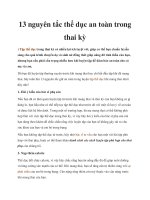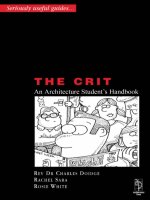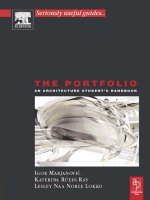The Crit: An Architecture Student’s Handbook docx
Bạn đang xem bản rút gọn của tài liệu. Xem và tải ngay bản đầy đủ của tài liệu tại đây (2.35 MB, 135 trang )
The Crit
This Page Intentionally Left Blank
The Crit
An Architecture Student’s Handbook
Edited by
Charles Doidge with Rachel Sara and Rosie Parnell
Cartoons by Mark Parsons
OXFORD AUCKLAND BOSTON JOHANNESBURG MELBOURNE NEW DELHI
Architectural Press
Architectural Press
An imprint of Butterworth-Heinemann
Linacre House, Jordan Hill, Oxford OX2 8DP
225 Wildwood Avenue, Woburn, MA 01801-2041
A division of Reed Educational and Professional Publishing Ltd
A member of the Reed Elsevier plc group
First published 2000
© Reed Educational and Professional Publishing Ltd 2000
All rights reserved. No part of this publication may be reproduced in
any material form (including photocopying or storing in any medium by
electronic means and whether or not transiently or incidentally to some
other use of this publication) without the written permission of the
copyright holder except in accordance with the provisions of the Copyright,
Designs and Patents Act 1988 or under the terms of a licence issued by the
Copyright Licensing Agency Ltd, 90 Tottenham Court Road, London,
England W1P 0LP. Applications for the copyright holder’s written
permission to reproduce any part of this publication should be addressed
to the publishers
British Library Cataloguing in Publication Data
Doidge, Charles
The crit: an architecture student’s handbook
1. Architecture – Study and teaching – Great Britain
I. Title II. Sara, Rachel III. Parnell, Rosie
720.7'11'41
ISBN 0 7506 4770 1
Library of Congress Cataloguing in Publication Data
The crit: an architecture student’s handbook/edited by Charles Doidge with Rachel
Sara and Rosie Parnell; cartoons by Mark Parsons.
p. cm.
Includes bibliographical references and index.
ISBN 0 7506 4770 1
1. Architectural design–Study and teaching–Handbooks, manuals, etc. 2.
Architectural design–Evaluation–Handbooks, manuals, etc. 3. Architectural studios
–Handbooks, manuals, etc. 4. Communication in architectural design–Handbooks,
manuals, etc. I. Doidge, Charles. II. Sara, Rachel. III. Parnell, Rosie.
NA2750.C75
721–dc21 00–038977
Composition by Scribe Design, Gillingham, Kent
Printed and bound in Great Britain
Foreword vii
Acknowledgements ix
Introduction xi
1 What is a review? 1
2 Before a review 21
3 During a review 43
4 Learning from a review 65
5 Alternative reviews 87
6 Reviews and the future 107
Bibliography 115
Index 116
Contents
This Page Intentionally Left Blank
The mysteries of the ‘jury’, ‘crit’, or ‘review’ have been enshrined in
design education for over a century. Projects and reviews introduced
‘learning-by-doing’ into design education at the Ecole des Beaux Arts
(School of Fine Arts) in Paris in the 1890s and they continue to hold
centre stage into the twenty-first century. For hundreds of thousands
of students around the world, the design project has been, and
remains, the primary method of learning and, in one form or another,
culminates in reviews.
Despite its centrality, this ‘vital learning vehicle’ (if you believe tutors)
or ‘boring waste of time, ego-trip for staff’ (if you believe students)
appears to take place without the benefit of a student guide. Students
are expected to learn the rules of the game without a rule-book and
initiation into this ritual can be a painful rite of passage.
Authors have visited this territory before and, in particular, Kathryn H.
Anthony’s wide-ranging ‘Design juries on trial – the renaissance of the
design studio’ offers an excellent overview. However, this ‘seriously
useful guide’ is believed to be the first aimed primarily at students. It
is written and illustrated by recent graduates with their student experi-
ences still vivid in their minds.
Many students think of ‘the crit’ as an ordeal devised by tutors to
leave them feeling as though they have been ‘undressed in public’.
This need not be the case. This guide shows how to prepare for the
rigours of the ‘traditional crit’ and suggests other less confrontational
models including student-led reviews. Instead of thinking of the
Foreword
design review as the ‘judgement seat’, it can be developed as a
celebratory experience.
This guide describes the game, identifies the rules, and advises on
tactics. It is a survival guide to help unravel the mysteries and offers
practical advice and clarifies objectives. It suggests a more rewarding
model appropriate to a ‘new professionalism’ that is less arrogant and
sees clients and users as creative partners in the design process. This
was one of the significant outcomes of the recent Clients and Users
in Design Education (CUDE) Project in the Sheffield and Leicester
Schools of Architecture.
We recommend this book to all design students and particularly to
architecture students. It invites and challenges students to be
partners, rather than passive recipients, in their educational
processes. It can go further and prepare students to be catalysts of
the same processes with future clients. It is hoped that design tutors
might even take a sneak look at this guide as well and discover with
their students that it is never too late to learn.
Professor George Henderson
Head of The Leicester School of Architecture,
De Montfort University
President of the Commonwealth Association of Architects
Professor Jeremy Till
Head of the School of Architecture,
The University of Sheffield
Leicester and Sheffield, January 2000
viii Foreword
This guide is indebted to numerous tutors, practising architects,
fellow students and other writers who have taught, learned, shared
experiences and contributed ideas. In thanking them for their inspi-
ration and sometimes provocation, we would like to stress that the
views are essentially those of the authors.
The catalyst was a project called ‘Clients and Users in Design
Education’ (CUDE) sponsored by the HEFCE (Higher Education
Funding Council for England) fund for the development of teaching
and learning. CUDE was initiated in 1996 by John Worthington of
the Institute of Advanced Architectural Studies at York, Professor
Bryan Lawson at the University of Sheffield School of Architecture,
and Professor George Henderson and Judy Ashley at The Leicester
School of Architecture, De Montfort University. The project included
enhancing student skills of listening, communication and teamwork,
through a collaborative rather than confrontational approach to
learning.
CUDE was directed in the latter stages by Simon Pilling with support
from Angela Fisher, Dr David Nicol, Martin Brookes and Andrew
Cooper. To Simon goes the credit for negotiating this guide through
its initial stages.
At Sheffield, CUDE was co-ordinated by Angela Fisher, with
workshops developed by Simon Pilling, Susan Stern and Martin
Brooks. The ‘in-school’ team was Derek Trowell, Mary Roslin, Helena
Webster, Dan Wrightson, Pru Chiles, Russel Light, Eammon Canniffe,
Acknowledgements
Simon Gedye, Dr Roger Harper, Judy Torrington, and Professor Peter
Tregenza.
At Leicester, Judy Ashley died of cancer early in the project and
subsequent work was co-ordinated by Jos Boys and Ross Wilmott.
The Leicester ‘in-school’ team included Professor George Henderson,
Revd Dr Charles Doidge, Dr Tim Brindley, Mel Richardson, Tony
Archibold, Dr Sahap Cakin, Richard Short, Mike Ashley and others,
with Dr Margaret Wilkin as external educational consultant.
A special ‘thank you’ is due to Mark Parsons whose inspiring cartoons
and rugged handsomeness have kept the authors going; they have
even admitted that they would buy the book for the cartoons alone! It
is hoped that the humour and detail will reinforce their poignant
messages.
This is an evolving tale and the authors will be pleased to receive
comments and anecdotes, via their universities, for possible inclusion
in subsequent publications.
This book is dedicated to Theres, Louis, Steve, and Kim.
x Acknowledgements
This book should be called ‘a study of the blatantly obvious’. It is
mostly common sense and, if you stopped to think about it for long
enough, I’m sure you could write a very similar guide yourself. The
thing is that few of us ever stop to think about the point of our crits
and we are expected to master them through trial and error. By the
time you do master the crit, it is too late!
This book aims to demystify the process, and provide a practical,
hands-on guide – how to survive in the current system and then how
to begin to change that system.
The crit, or ‘review’, as we are going to call it throughout this guide,
is a feature of studio-based design courses. The design studio is an
unusual kind of beast in the university environment and is the part of
an architecture course that generally takes up the most time and
effort. Typically a design project is set and students are given a limited
amount of time to explore it and present their ‘ideas’ or ‘solution’ at a
review. Other aspects of the course, such as history, technology,
design theory, etc. are intended to feed into the studio project. For
most of us, the review is unlike any previous experience.
The role of the review has been the focus of recent appraisal (Hall
Jones 1996, Anthony 1991, Wilkin 1999). What is the purpose of the
review? Should we continue with them at all? Do students learn
anything from them? How do they relate to professional practice? This
guide does not attempt to extend the theoretical debate but, instead,
Introduction
makes explicit the negative aspects and then the potential value of
‘traditional’ review and suggests ways to improve performance and
learning. We also suggest a range of alternative reviews which you
can implement yourself.
It is a ‘how to’ rather than a theoretical kind of book, but certain
changes to the review are implicit – changes which work towards a
new professional attitude of inclusiveness, participation and collabo-
ration. We acknowledge the viewpoint that many professionals
develop a ‘tacit knowing-in-action’ (Schön, 1983) and that it is not
always possible to articulate this knowledge fully. We do not aim to
provide a rule-book, but a framework for thinking about the review
within which you can develop your own approach.
Rosie Parnell
My first experience of a review was heart-pumping; it was unlike
anything else I had ever had to do but I was expected to just get on
with it along with the rest of the year. Okay, so it was interesting to
see what other people had produced but why did everyone have to
stare at me and my pathetic bits of collapsing cardboard and masking
tape and those terrible drawings ouch! My non-architect friend had
inspired me with confidence just before by telling me that my first
creation, my pride and joy, looked like a great big toilet roll. So all in
all, the whole excruciating experience felt like a perverted form of
punishment.
As time went on and I thought I was turning into a bit more of an
architect (started wearing more black etc.), the review became an
accepted event at the end of each project. My voice still insisted on
disappearing into my shoes every time it happened so that I
sounded like a Dalek, but with a bit of experience behind me I felt
marginally more confident. Unfortunately my marks didn’t seem to
reflect this, and after each review I would be relieved to be able to
begin a new project saying, ‘This time, this is the one, this is going
to be great!’ I still didn’t really stop to think, ‘What are reviews all
about?’
During the Diploma years, Rachel Sara and I worked together, first
on short projects with others and then on a year-long project as a
pair. It was a great experience. We developed a method of working
xii The Crit
which seemed to be very efficient, at least judging by the funny looks
we got every week from our colleagues when we said that we were
going off to London for the weekend, or going to our pottery night
class; it seemed that we had a lot more time off than other people.
What is more, much to our amazement, our marks started to climb.
Neither of us would claim to be natural designers but by the end of
the course, our work was being nominated for the RIBA Silver
Medal. What was going on here? To this day, all we can think is
that our working method must have been effective. Now, I know that
on the surface this does not seem to be directly related to the
review, but in all of our work we were planning, preparing and
looking ahead to that review. Everything that we did was part of our
preparation for the review presentation and it helped to define our
working method.
Through the Diploma experience and through exposure to a research
project called ‘Clients and Users in Design Education’ (CUDE, which
explored things like the review, presentation techniques and group
work), both as students and researchers, we learned techniques for
review management and preparation. Perhaps most importantly, the
CUDE project, combined with recent experience as design tutors, has
allowed us to recognize the enormous potential of the review process
as a learning experience.
Rachel and I are both involved in tutoring part-time, and as a result,
we now experience the review from another point of view. It is so nice
to have the pressure off! However, there is a different pressure to
perform. As a tutor I feel I am expected to have an amazing insight
to share with every student. It can be really exhausting and frustrat-
ing when I just cannot work out what is so fundamentally flawed with
student X’s piece of work, or what is so brilliant about student Y’s. I
have begun to understand what makes a good review presentation
but I would be the first to admit that someone could come along and
break all the rules, talk into their shoes, present their work in the style
of Donald Duck and yet be convincing. For the rest of us, however,
a bit of pre-planning might be a better approach.
So, these days I’ve graduated to the trendy glasses brigade – I must
be feeling fantastically confident! I’m not sure whether that’s true, but
it is my sincere hope that this guide can help you to make more of
your review process, and in so doing make more of your architectural
education.
Introduction xiii
Rachel Sara
For me, the beginning of the architecture course was a terrifying time.
I was suddenly deposited in a city I’d never been to before to share
a house with people I’d never met. To make matters worse, I seemed
to be on a course that involved more work than anyone else’s, in a
subject that I didn’t have a clue about. At the beginning of each
project, I’d read through the brief and wonder what on earth it all
meant. I then typically spent the first half of the project doing what all
first years on other courses were doing (which was anything but work)
and the second half of the project frantically trying to ‘pull a white
rabbit out of the hat’ for the review. By the time it got to the actual
event I had had so little sleep that I felt like I was swaying. I would
end up spending the following week recovering in bed!
The first review I really remember was one where I had produced a
model. I had worked entirely on my own at home which I realize now
was a terrible idea. Having done an ‘all-nighter’ to finish off the
cardboard monster that I had begun, I left home feeling weird, but
fairly happy with my work (it was, after all, my first ever model). When
I got to the studio, my heart sank I was so mortified by the shame-
ful quality of my work in comparison with that of other students that I
burst into tears. The review did not go well.
I do have memories of reviews that went well, but I have to admit that
I don’t remember ever learning much from the experience. I certainly
never asked myself what reviews were for, or what I wanted to get
out of them (other than praise, praise, praise!) When it came to other
people’s work, I have a recollection of the occasional project which
the tutors would unanimously deem brilliant. This would instil in me a
feeling of extreme jealousy, soon followed by wonderment and confu-
sion. ‘Why was their scheme so good?’ I asked myself, but (mistak-
enly) never stopped to ask anyone else.
The whole thing was a real shock to the system. I had always done
well at school, but this was something else. I would feel full of inspi-
ration and excitement at the beginning of each project, coupled with
a ‘I’m really going to learn from that last project, and this one’s going
to be brilliant’ feeling. But at the end of each project, I would have to
face up to the fact that yet again, my work was not ‘brilliant’. My marks
were generally reasonable, but I couldn’t help thinking that if only I
had done a more normal subject (like English or Maths!) I would be
doing so much better.
xiv The Crit
It wasn’t until I came back to study for the Diploma that things started
to fall into place. I realized that studying architecture was a fantastic
opportunity for me to explore issues that really interested me.
Architecture suddenly seemed to be relevant to everything and I loved
it (particularly when I realized that all-nighters weren’t compulsory)!
At the end of the Diploma course, I began working in practice part-
time. I found myself having to explain work to the client and really
having to sell the work that I had done. It took me a while to realize
that I could apply my experience with reviews to these situations. I also
got involved in participatory design sessions with various groups. I
found it really refreshing to ‘talk architecture’ without the jargon; it was
a completely different experience from anything I had done at univer-
sity. After spending so many years learning to design to my own and
my tutors’ agendas, it was a totally different thing to incorporate the
users’ views into my work. Why hadn’t I done this in my education?
The CUDE project was an excellent opportunity to look at how clients
and users might be introduced into future architectural education.
No description of the architecture course can really express what it is
like to be an architecture student. But be assured, there are people
all over the world who feel as confused, excited, terrified, inspired and
challenged as you do. I hope this guide makes you think about
reviews – even if it just makes you stop and think about the blatantly
obvious for a minute.
Mark Parsons is a recent graduate of the Sheffield University
School of Architecture now working in practice.
Charles Doidge was formerly leader of undergraduate architecture
at The Leicester School of Architecture, De Montfort University.
Format
The book is formatted to include cartoons, quotations and background
information (in grey) alongside the main body of the text. The quota-
tions recall what many remember only too well, and are drawn from
interviews carried out by the authors, comments made by Rachel Sara
(RS) and two others texts as referenced.
Introduction xv
This Page Intentionally Left Blank
What is a review? 1
This Page Intentionally Left Blank
Synopsis
What is a
review?
‘Excellent fun! I
always thought they
were a bit like a
sport – sparring or
jousting. They were
usually
unnecessarily
aggressive affairs,
but all done in good
humour among a
group of friends.’
Practising architect
‘It’s a deadline.’ Final
year student
This guide begins with a look at the what and
why of reviews. The review process is intro-
duced and the different types of review held at
various stages are described with examples.
The potential value of the review and the possi-
ble negative aspects are explored. The review
at its worst is exposed and contrasted with the
best case. Within this framework, the role of the
tutor is discussed and the potential role of a
participant is explored.
Crit, jury, or review; whichever term you recog-
nize, the quotations show that people have
widely differing views of the experience. So what
is it exactly?
If you heard the terms ‘jury’ and ‘crit’ for the first
time you’d probably presume, quite understand-
ably, that they described something negative –
maybe even something downright unpleasant.
‘Is a jury going to put you on trial?’ (see
cartoon 1). Is a crit simply criticizing? These
terms don’t imply that there is a positive side to
the review process. But there is! The review has
great potential as a learning experience and this
is the reason that it is a firmly established part
of most architecture courses. This guide is
1 What is a review?
Cartoon 1
‘Is a jury going to put you on trial?’
4 The Crit
called ‘The Crit’ because that term is familiar to
most people but we use the term ‘review’
throughout to promote the more positive aspects
of the process.
Your review will vary according to your school,
personalities involved and the stage you have
reached. When you stop to think about the
review and its function, you will realize that it is
a surprisingly complex beast. It might be helpful
to outline the sort of things you should expect.
• Reviews are held both during and at the end
of a design project.
• You will present your work and ideas on your
own or in a group.
• It could be informal or formal – a chat around
a table or ‘a presentation to rows of seated
individuals’ (see Diagram 1).
• You will usually present a visual and verbal
explanation of your work.
• Yours will be one in a series of presenta-
tions.
• You will probably have a limited amount of
time.
• The audience could be small or large,
students in the same year as you, students
from other years, tutors involved in teaching
the project, other tutors, architects and
specialists, or lay-people such as clients and
users.
• The audience may give you feedback on
your work and discuss ideas with you and
each other.
• There is the potential for you to learn from
everyone involved.
• You might be marked during the review.
What is a review? 5
‘It’s an evaluation of
the work that’s been
done.’ Tutor
‘A pointless event,
unnecessarily
negatively critical.’
Practising architect
‘It’s partly an
assessment of the
project but also
controlling a
meeting,
presentation in
public and other
useful skills.’ Tutor
‘A chance to get the
sleep you didn’t get
the night before.’
Architecture graduate
Outline of
reviews
Initial stages
You might be expected to discuss the findings
of any research you have done with other
students and tutors, or even to make a formal
presentation. This is the perfect opportunity to
learn from others and to bounce around your
initial ideas.
Forms of review most likely at this stage:
• Round-table discussion with students and/or
tutors.
• Small/medium group tutorial with your
tutor(s).
6 The Crit
The review
stages
Diagram 1
A presentation to
rows of seated
individuals
• Meeting with clients or users.
• Question and answer session with an expert,
e.g. an engineer.
What is a review? 7
The review in the Ecole des Beaux Arts
The Ecole des Beaux Arts, founded in 1819,
was the leading centre of architectural
education in France (Crinson and Lubbock,
1994: 76) and is seen by many architectural
educators as an early precursor to the model
of architectural education we experience
today.
The design problem was developed as the
main method of teaching architecture and the
review was used as a way of evaluating
work. These reviews were carried out behind
closed doors by design tutors with no input
from students. Since the mid-twentieth
century, this process has evolved into an
open format. In contrast to the original
system, the open, public nature of reviews
today is fundamental to the process (see
Anthony, 1991: 19).
Intermediate stages
Most design projects involve a presentation of
‘work in progress’ (an interim review). Up to this
point you might have discussed your work only
in one-to-one tutorials or with friends. An interim
review allows you to present your work to a
larger audience and get a variety of opinions
from your peers and tutors. You could be looking
for inspiration or you might want specific advice
on how to progress.
Forms of review most likely at this stage:
• Round-table presentation.
• Small/medium group tutorial.
• Formal spoken presentation to a group with
work on display.
Final reviews
The final stage of the review process is likely to
be more formal than earlier stages; this is why it
can be the most nerve-wracking stage, particu-
larly if you know that your work is being marked.
Like the interim, you can get feedback and learn
from the discussion. The principles you learn here
can be applied later. In the final review there
might also be an emphasis on practising presen-
tation skills for your future life as an architect.
Form of review most likely at this stage:
• Formal spoken presentation to group with
reference to work on display.
• Exhibition of work with no verbal presentation.
Review: best case
When the review process is working well, it
provides many learning opportunities:
• A chance to evaluate work. Reviews are
never purely a chance to mark work. They
provide an opportunity for you to view your own
8 The Crit
Review
scenarios
‘Reviews are there
to build a mutual
respect – they’re a
public forum.’ Tutor









